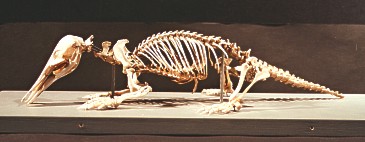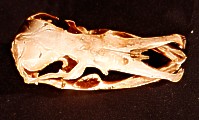
The platypus (Ornithorhynchus anatinus) lives in the lakes, rivers and streams of Eastern Australia. It is specialized for an aquatic life by having webbed fore and hind feet, along with a horizontally flattened tail which can act as a rudder. The body is exceptionally well stream-lined to reduce resistance when in the water. The platypus' fur is exceptionally waterproof. An outer layer of long flat-bladed guard hairs and an inner layer of fine hairs, which trap air, help to keep the body at a suitable temperature. The platypus can stay submerged for up to 12 hours at a temperature of zero degrees celsius. The platypus has very sensitive sight and hearing when above water but its eyes and ears are closed when under water. The male platypus is about 50 cm long and weighs about 1.7 kg; the female is slightly smaller weighing less than a kg. Platypuses can live for 10 years or more. When the offspring are born, they have a spur on each hind-leg; the males retain theirs for life, but the females lose theirs within a year. The spur, which is connected to a venom gland, is about 1.5 cm long and can inflict a very serious wound. The spur is used to defend the animal against predators and to attack other males during the breeding season. The venom is strong enough to kill a large dog. The spur on a male's hind leg. Platypuses feed on insect larvae, fresh water shrimps, bivalve
molluscs, frogs and fish eggs. They have an exceptionally sensitive
bill, covered by thousands of electro-sensitive pores to detect
electric signals generated by the muscle activity of small prey.
When foraging they dive repeatedly, storing food in specialized
cheek pouches. The young possess teeth that are lost as the animals
mature. Adults have horny buccal pads for grinding their food.
Platypuses live in long pools with consolidated angled banks
where they find the firm earth they need to dig their burrows
and build their nests. The young live in special breeding burrows.
They feed on milk, which they suck from the hair around the openings
of the mother's mammary glands The pools, where platypuses ae found,
must be slow moving, about 1-2 metres deep, abundant in aquatic
vegetation and benthic vertebrates. At present, the platypus is
not considered an endangered species, however the most suitable
habitats for this animal occur in the most densely populated areas
of Australia and their numbers have been locally reduced due to
habitat destruction and degradation.
|









